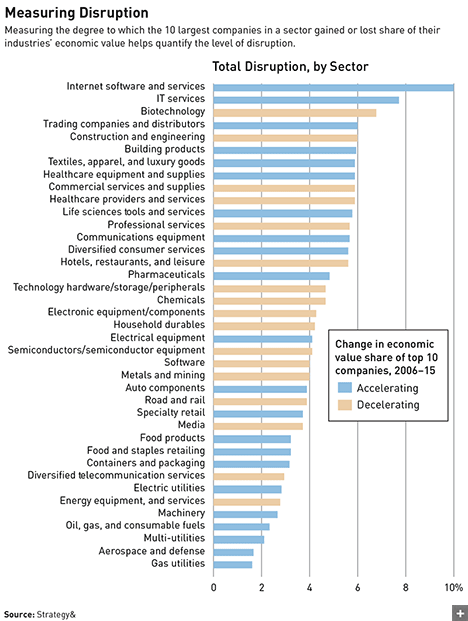The fear of disruption can be more damaging than actual disruption
Resist the urge to react too hastily to major change — or to use it as an excuse not to take action. Focus instead on making the fundamental strategic choices necessary to strengthen your business. See also “Disruptors and the Disrupted: A Tale of Eight Companies — in Pictures.”
Business leaders are always worried about disruption. Some high-tech rival might, after all, do to their sector what smartphones did to the photography industry, what e-commerce is doing to retail, and what financial technology (fintech) is threatening to do to consumer banking. In PwC’s 2017 survey of 1,379 chief executives around the world, 60 percent said that technological advancements had significantly changed or completely reshaped competition in their sector in the last five years, and more than 75 percent anticipated they would do so before 2022.
And yet, in a recent study tracking the real-world impact of competitive upheaval, we found that the fear of disruption is exaggerated. Although we have no crystal ball to predict exactly how much disruption will take place during the next five years, we have found that companies facing disruption generally have longer to respond than they expect, and an effective response is available to them. When disruption does affect a company, it’s frequently because the enterprise was already vulnerable in some fundamental way; moreover, many incumbent companies accelerate their decline through their efforts to forestall it. Panic-driven efforts to avoid or combat disruption can easily lead to hasty, reactive, short-term-oriented decisions that move a company in many directions at once, distracting its management and squandering its resources. The fear of disruption can thus be worse for a company than the actual disruption itself.
The fear of disruption is harsher in its effects than the actual disruption would be.
Of course, complacency or inaction can be just as problematic. Technological changes, and other external competitive forces, affect many business realities. Proactive measures are often needed. But they should be well thought out and center around those advantages that you already have and that you already control — your own strategy and strengths — rather than representing a rash overreaction to external forces largely outside your influence. Instead of letting anxiety about disruption lead your strategy, concentrate on making the investments that can build an identity for your company that is strong and resilient in the face of change.
Disruption’s Pace and Impact
To better understand the real pace and impact of disruption, our research group at Strategy& (the global strategy consulting team at PwC) set out to measure disruption in multiple industries over significant period of time. Because there is no readily available metric for disruption, we settled on a reasonable proxy: major changes in relative market capitalization among a sector’s 10 leading companies. When the prevailing business model of an industry is threatened — by innovations from a player within the sector, by startups, or by competitors invading from another industry — the inevitable result is a shift in enterprise value from one group of companies (the incumbents) to another (typically the upstarts, or on occasion incumbent companies that disrupt themselves). For example, when Apple disrupted the recorded music industry in the mid-2000s, a shift in enterprise value was visible — away from the incumbent market leaders, such as the Sony, Warner, and Universal music groups, and toward Apple (and eventually to other tech entrants, such as Spotify).
We therefore measured total enterprise value (EV) for the largest 10 companies worldwide in each of 39 key industrial sectors over a 10-year period ending in 2015, tracking the share of that total EV held by each company. This allowed us to recognize when major shifts in EV occurred, and thus to identify major cases of disruption (see “Measuring Disruption”).
When we tabulated the results, we found that most industries have not been dramatically disrupted; the turnover in sector dominance, when measured this way, is relatively low. The industries undergoing the largest EV shifts were Internet software and services, IT services, and biotechnology. These three sectors are heavily dependent on technological innovation and subject to turbulent change. But even here, the changes in EV share of the top 10 players averaged only 8 percent over the full 10-year period. Significantly, several industries widely seen as threatened by outside technological competitors — such as aerospace and defense, diversified telecommunications services, media, and specialty retail — registered among the lowest levels of disruption found in our study. There was technological change, to be sure, and the industries faced pressure, but there was no significant shift in the roster of leading companies.
Our research also showed, contrary to conventional wisdom, that the rate of disruption — the annual shift in enterprise value — is not increasing. The average disruption level across these 39 industry segments showed only a miniscule increase over the 10-year period from 2006 to 2015, from 2.2 percent for the first five years (2006–10) to 2.3 percent for the second five years (2011–15). The single outlier was the Internet software and services industry, where disruption levels increased by 3.1 percentage points after 2010. There were 21 other sectors with increases in disruption, albeit much smaller ones (none over 1.6 percentage points), while 17 had decelerating disruption (higher levels on average before 2010). This finding reinforces our belief that there is time to prepare for disruption and that disruption will not hit every single sector overnight. (For the five-year churn calculations, we used two-year averages of share [for example, 2006–07 versus 2009–10] to reduce the impact of any one-year outliers. The 10-year churn calculations are the sums of the two five-year churns for that industry segment.)
Finally, the pace of disruption — the time it takes to appear and have impact — is generally much slower than the conventional wisdom may suggest, and thus easier to deal with. For example, the pharmaceuticals industry has been considerably affected by external forces, including regulatory upheavals. But these events have unfolded over the course of 10 years or more. In the internet software and services sector, it took nearly a decade after the invention of the Web browser in 1990 before the Google search engine made the Web practical for e-commerce. The current disruption in the retail industry, in which economic value is moving to online players such as Amazon, has been dramatic, to be sure. But even here, it has taken more than a decade to reach a tipping point.
The automotive industry is at the start of just such a period. Massive changes appear to be inevitable: connected cars, autonomous vehicles, battery breakthroughs, and the like. But these changes will probably take decades to be fully adopted. The vehicles themselves have been in development for years now, and their potential impact has been analyzed extensively through computer models. Many critical factors will slow down their adoption. These include technical factors, such as the difficulty of designing vehicles for a wide variety of terrains and climate conditions. Incumbent automakers have built up fundamental advantages in design, manufacturing, distribution, sales, and financing, making it hard for new entrants to compete. All manufacturers, old and new, will need time to ramp up so they can produce the necessary technologies at scale. The transition will also require new types of auto repair shops, new fleet-management companies with new sources of capital for financing them, new forms of auto insurance, and new traffic and safety regulations. And then there’s the installed base to consider: It could take 30 years or more to replace the existing automobile population with self-driving cars. As the Economist pointed out in a 2015 article titled “The Creed of Speed,” auto executives have plenty of time left to create an advantaged position for their company — if they start now.
Developing Strategy
What does this suggest for your strategy? As we noted at the outset, you shouldn’t try to be faster than potential upstart competitors; you should aim to be better. The impact of a sector-wide disruption on any particular company depends on how well that company can maintain a fundamental advantage compared with others within its sector. We’ve long observed that great capabilities — those few things that allow you to be better than your competition at what matters to your customers — typically outlast markets. Without them, you are at the will of others to redefine your space; with them, you have tremendous abilities to shape your own future.
Start with a thoughtful review of the sustained advantages you have already built — your capabilities, brand value, and relationships. Then double down on your investments in your strengths. They will give you the flexibility you need to survive and thrive amid disruption.
Netflix has done exactly that in pivoting through the rapidly changing, often-disrupted business environment of the recorded media and entertainment sector. In the late 1990s, the company competed directly with the Blockbuster retail chain through a mail-order distribution service that explicitly acknowledged its patrons’ love of convenience and their irritation with à la carte pricing and late fees (Netflix’s subscription model let customers keep a DVD as long as they wanted). In 2007, when streaming video became viable, Netflix rapidly pivoted to offer that service. In 2013, it began creating its own shows, and it has pioneered the use of artificial intelligence and machine learning to discern consumer interests. A distinctive core strength — the ability to understand what its customers want and do, using in-depth analytics and behavioral data captured by the company — enabled Netflix’s growth.
Another example is Honeywell Systems, the industry leader in the heating, ventilating, and air-conditioning (HVAC) sector, which pivoted to its strengths with its successful new line of digital building climate control devices. But the company could have been a victim of disruption. It was a competitor, Nest Labs, that introduced a digital thermostat in 2011 that was one of the first devices to use machine learning. The device recognizes inhabitants’ heating and cooling habits and adjusts its settings accordingly. Founded by two former Apple engineers, Nest Labs was seen from the start as a threatening force to incumbent competitors such as Honeywell — and its disruptive activity kicked into high gear when, in 2014, Google acquired the company.
But Honeywell had great capabilities of its own. The company is a consummate fast follower, skilled at adapting technologies with flawless execution of every aspect of design and operations. (Former CEO Larry Bossidy is coauthor, with Ram Charan, of the leading book on the subject, Execution [Crown Business, 2002].) One of Honeywell’s particular strengths was its embedded base of relationships with distributors, large-scale contractors, and other leaders in the industrials, building, and HVAC industries. No matter how many Nest thermostats consumers wanted to buy, their electricians and HVAC professionals were more familiar with Honeywell. This advantage gave Honeywell time to address its weaknesses in software user interface and product development, so that its products could compete effectively against the Nest devices. This story may not be over — and both competitors will have to sort through the relative value of products, distribution and the data and software that support next generation services.
By contrast, consider one typical example used to bolster fear of disruption: the impact of ride-sharing companies (such as Didi Chuxing, Lyft, Ola Cabs, Sidecar, and Uber) on taxi companies in many cities. Some taxi companies had only three advantages of their own to draw on: drivers who knew how to navigate the streets, a dispatching and hailing system already in place (including the taxi lines at airports), and a high level of government protection in many cities, where the number of taxi medallions was restricted. Global positioning and smartphone app technologies have undermined the first two advantages, and the third is under fire. In addition, one could ask: Were taxi drivers and phone dispatchers universally courteous? Were vehicles always clean? Did the companies consistently deploy the latest technology? The answers to all questions would have to be “no.” This lack of real advantage has made the taxi industry been highly vulnerable to disruption for years — and only now that they are threatened are many municipal cab companies raising their game by introducing hailing apps and improving other amenities.
Had the taxi industry been more attentive to its customers, it might not have been threatened at all. It would have been more like the hotel industry. We are not aware of any major hospitality company that has been hurt by Airbnb’s success. Airbnb has actually helped the rest of the hospitality sector by increasing travel among all demographic groups. It has also prodded some hotel chains, such as Marriott and Starwood, to improve their own offerings, thus expanding their business customer base. Indeed, when Marriott and Starwood merged in 2016 to become the world’s largest hotel chain, one of the most-noted aspects of the deal was the combination of their customer loyalty rewards programs, bringing together the best features from both sides to attract and retain customers.
Building on Your Strengths
If having a solid core of capabilities is so effective, why are business leaders so ready to believe that agility, or even no reaction at all, is a better response to disruption? Often, it’s because of natural cognitive biases: People tend to overestimate the power of a threat and underestimate the time they have to respond.
This apprehension leads some companies to a state of strategic paralysis, holding cautiously to business as usual and avoiding risk. Their lack of confidence appears to be linked to a lack of self-awareness; they don’t appreciate their own strengths enough to double down on them and make them viable. They are like the Polaroid Corporation, which was an early pioneer in digital imaging dating back to the 1960s, but which did not make the necessary investments to hold that lead in the 1990s, despite the fact that the company best represented “instant satisfaction” which was a core proposition of the digital camera.
Other companies react to the perceived threat by doing too much. They “let a thousand flowers bloom,” placing bets on many new ventures, and launching digital ventures in new places (we call these pirate ships), even when it’s not clear that they have the capabilities needed to succeed in most of them. Unfortunately, because these moves are disassociated from the company’s core strengths, they are also less likely to be effective. They become distractions, exhausting the company’s resources and taking time and effort away from more productive strategies.
In both cases, the company leaders avoid the difficult work of developing a better strategy and implementing the fundamental changes that are needed to build competitive advantage. The result? They’ve grown more vulnerable to disruption — and also to ordinary competition. Meanwhile, a few competitors, some of whom were beleaguered incumbents, have probably figured out ways to build on their own strengths, which puts them in a position to dominate the sector.
When we talk about these issues with senior business leaders, they recognize the logic. But they often say that the external world is so volatile and the threat of disruption so unpredictable they don’t have time to change all the people, processes, and systems required to build the differentiating capabilities they need. There is a strong point of view that increasing agility is the best way to compete directly with new entrants.
Those who hold this view can have two types of agility in mind. Operational agility is the ability to muster a team on a project rapidly and organize around results, as “sprint and scrum” teams do regularly in Silicon Valley and elsewhere. Operational agility is extremely valuable, but in itself will likely not enable a company to mobilize at the scale needed to affect its entire strategy.
The other type is strategic agility — e.g., the ability to rapidly introduce and sustain new successful products and services to meet new market needs. Although strategic agility may be beneficial, on its own, it is not an adequate answer to the new business models that may threaten you.
Ultimately, the best defense is with neither form of agility, at least in itself. It is far better to create advantage through a few distinctive, deeply ingrained capabilities that allow you to deliver on your value proposition better than anyone else. Although it may take years to fully build them out, significant results will begin to appear much more rapidly in most companies. Apple proved that when it began developing its digital hub strategy in the late 1990s, which was based on the idea that the computer would be a central connecting point for all sorts of other devices. By 2001, six years before the introduction of the iPhone, Apple had already introduced an MP3 music player, a digital video camera, and its groundbreaking iTunes store. As for the risk, when you make moves based on your existing strengths, you can make them quickly enough, and incorporate enough feedback, to course-correct as you go along.
The successful companies profiled in our book Strategy That Works have faced down disruption this way. Their distinctive capabilities, such as IKEA’s cost-focused design, Amazon’s innovative supply chain, Danaher’s M&A prowess, or Starbucks’s innovative methods for recruiting and managing dedicated employees, give them the flexibility they need to shape their future.
These insights about disruption should feel empowering. When you are threatened, slow down and look at the data for your industry. You are likely to find that the disruption isn’t moving as fast as you think it is. That it isn’t hitting as much of the industry as you are afraid it is. And that in your existing strengths are the tools you need to thrive — either by tackling the threat, as Honeywell did, by staying in front of it, as Netflix did, or by building out your capabilities, as Marriott did. You’ll discover that you have plenty of time to focus on what matters most: a distinctive edge that even the disruptors can’t take away from you.
Author profiles:
- Paul Leinwand is global managing director, capabilities-driven strategy and growth for Strategy&, PwC’s strategy consulting business. He is a principal with PwC US.
- Cesare R. Mainardi is an adjunct professor of strategy at the Kellogg School of Management. He is the former CEO of Booz & Company and Strategy&.
- They are coauthors of Strategy That Works: How Winning Companies Close the Strategy-to-Execution Gap (Harvard Business Review Press, 2016).
- Sam Thomas also contributed to this article.






